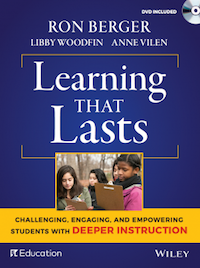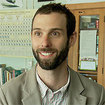Help Students Read & Think Like Scientists
 By Libby Woodfin
By Libby Woodfin
Peter Hill’s eighth grade students at King Middle School in Portland, Maine, are getting to do the work of real scientists. In Hill’s classroom, however, that doesn’t always mean putting on lab coats and goggles.
Peter knows that the authentic work of scientists is “10% experimenting, 40% writing, and 50% reading,” and he wants his students to have a middle school version of that reality in his classroom.
On the heels of an experiment conducted in class the previous week, Hill has planned a two-day lesson focused on a complex scientific text and designed to deepen his students’ understanding of how moving wires over magnets affects electricity.
It’s tempting to think that a text document, especially one that is challenging to read, may not be the best way to get eighth graders engaged in learning science. But Hill understands that simply experimenting hands-on with materials isn’t necessarily going to help his students learn or invest in their work.
His focus is on combining experiments with exploration of a well-chosen text and a purposeful plan to ensure that his students are challenged, engaged, and empowered. It’s the trifecta of deeper instruction. Though there are no lab coats or goggles involved in the two-day lesson described here, Hill’s students are palpably engaged in their work and clearly learning.
What follows are the three key instructional moves Peter Hill makes to challenge, engage, and empower his students.
Challenging (and supporting) all students to access and understand complex texts
Challenging students to read a complex text isn’t as simple as assigning it for homework, which may be effective for some students, but risks leaving many confused, frustrated, or simply disengaged. Students need strategies to access complex text so that they all have the same opportunity to learn from it. Hill challenges and supports his students in the following ways:
► He reads the text aloud so that students can hear it read once through fluently.
► As he reads, he pauses frequently to allow students to reflect on the text, make notes, and then share their thinking with their peers. They use a text-coding strategy called CAT-P—they note Connections, Ask questions, Translate the text into their own words, and make Predictions. (It doesn’t hurt that he injects a little humor into this acronym.)
► He collaborates with the ELL teacher to support his diverse group of readers with two different kinds of note-catchers—one that is a separate sheet attached to the article and another that is embedded within the article.
(Video: David Grant)
Engaging students in thinking and talking about the text
Asking yourself, “What tasks or experiences will help students learn about the topic more deeply?” is as important when planning close reading lessons as it is when planning a lab or scientific fieldwork. The questions you ask and the tasks you engage students in help them focus on creating new knowledge about scientific concepts rather than just retaining what they have read or heard. Hill engages his students in the following ways:
► He has printed out sheets with all of the disciplinary vocabulary words students will encounter in the text so that they can do a “pre-reading” activity called GPS—Glue, Paper, and Scissors (another creative acronym). In groups, students cut out the words and are tasked with arranging them on a piece of paper in a way that makes sense to them. Building this vocabulary concept map immediately engages students in thinking about what they already know about the words and how the text might help them answer questions they still have.
► As noted above, pausing while he is reading aloud so that students can think, write, and share their ideas with each other allows them to process their thoughts and pick up new ideas from their peers.
► Thinking about tasks that will engage students in evaluating and analyzing what they’ve read, he asks students to work in groups to identify and prioritize the importance of key pieces of information from the article. At stations organized by category each group writes down what they think is the most important piece of information within that category.
It is not uncommon during this activity to hear students saying the magic words: “Let’s look back in the article.” Each group rotates through and decides on the next most important piece of information and adds it to the list. Once finished, students have a comprehensive list that they have created together.
(Video: David Grant)
Empowering students to be leaders of their own learning
Helping students understand where their learning is headed, track their progress along the way, and make choices about how to approach their work empowers them to take ownership of their learning. Empowering students in this way also helps them develop a “growth mindset,” instilling in them the belief that intelligence is not something they’re born with, but something they can develop through persistence and strong habits of scholarship.
Hill empowers students and supports them to develop their growth mindset in the following ways:
► He uses learning targets to focus students on the intended learning. The learning target “I can explain how wires and magnets work to affect electrical energy” puts the intended learning in the students’ court. It’s not an objective for the teacher, identifying the material to be covered; rather, it’s a target for the students to help them know where they’re headed. They’ll know they’ve met the target when they can say, “I can.”
► He uses an online application called Socrative to conduct a ten-question pre- and post-assessment. Students get immediate feedback on their learning needs. As one student, Abubakar, says “Knowing what you don’t know helps with what you’re going to learn.” Citing trends and lifting up whole-class progress on the assessments gives the class a collective sense of accomplishment.
► As mentioned previously, he works with the ELL teacher to create two different versions of the note-catcher. But rather than handing these to students, he allows students to choose the version that makes the most sense for them.
This strategy encourages student to be metacognitive about their learning styles and needs. “I chose an article that had a sheet and then an extra note-catcher attached to it,” says one student. “I tend to write a lot and by having that extra space it makes me want to write more and have more detail in it.” Another student makes a different choice: “I chose one that would suit me best on my level on the topic of electricity. The one I chose had a vocabulary section and a section where you can take notes.”
The trifecta is achieved
Peter Hill’s careful planning allows him to deliver deeper instruction that challenges, engages, and empowers his students. With a complex text acting as the “second teacher” in the classroom, his students learn important literacy skills and engage in the authentic inquiry and knowledge building of real scientists.





































Terrific article, Libby! This should be mandated reading for ALL language arts teachers.